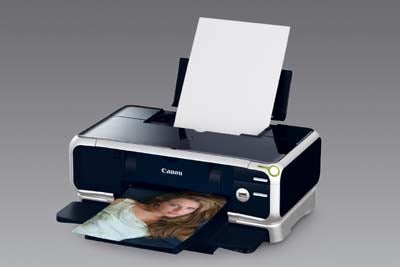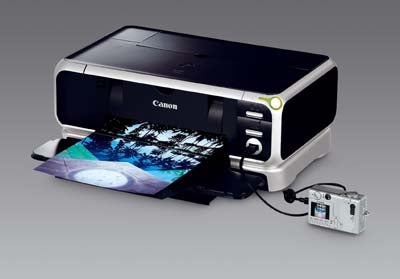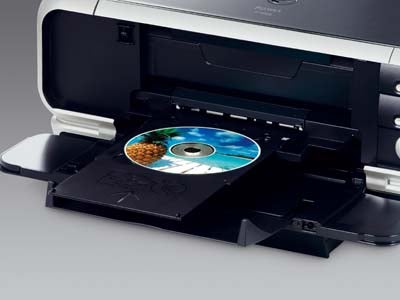Canon Pixma iP5000 – InkJet Printer Review
Canon Pixma iP5000 – InkJet Printer
Not only is the Canon Pixma iP5000 a great looking printer, it also provides high-quality prints, impressive flexibility and great value for money.

Verdict
Key Specifications
- Review Price: £144.00

If you’re after an inkjet printer which does the lot, Canon’s new Pixma iP5000 has to be a serious contender. Designed to cope with most home and many home-office tasks, it also boasts the first use of one picolitre (1pl) ink drops, for a very fine gradation of tones in photographic output.
Looking something like a large, Chinese lacquer-work box, the Pixma iP5000 is unusually finished in high-gloss, black plastic, with broad silver highlights along all edges. It’s a substantial machine for an inkjet, standing slightly higher than a typical desktop PC case and with a similar footprint.
At the very least, you need to click open the front panel and extend the telescopic paper tray before you can start printing. You don’t, however, have to raise the paper feed tray from the printer’s top surface, as there’s also a multi-size, 150 sheet cassette which slides in under the body of the machine.
For day-to-day A4 printing, you can rely on the cassette and leave the printer closed up. Paradoxically, you can alternatively use this cassette for glossy film stock, for the occasions when you need to print photographs, leaving the top feed for plain paper. Since both forms of paper feed can take a variety of different sizes and shapes of media, the combinations are many and you can set up the printer to best suit your requirements.
A third method of feed involves folding down a secondary tray from the front of the printer. This is a specialist use, as the printer then accepts a CD tray for direct printing on CD or DVD media, or even on the credit card-sized CDs sold for marketing or business card use.
But we haven’t finished with the convenience features of the iP5000 yet, as it includes an integrated duplexing unit, so the printer can print on both sides of the paper in a single job. There’s also a USB socket to the right of the paper out tray which can be used to connect a digital camera. If that camera conforms to the PictBridge specification, you can print directly from it, without the intervention of a PC. The only obvious omission from the feature set is memory card slots – there’s no way to transfer images directly from cameras without PictBridge.

At the back of the Pixma are mains and USB sockets, and once you’ve set up the driver and status software, the printer installs without problem. Canon’s printer driver is well laid out, with a tabbed dialogue offering simple control of watermarks, overprints and page imposition.
The ability to print a number of different impositions, such as two and four pages to the sheet, can produce good economies on internal drafts and help with assessing page layouts in longer documents.

Duplex printing can be switched on from within the driver, too, and can be set to duplex along the long edge (book) or short edge (flip-chart).
With its deep print head, the Pixma iP5000 can print black text quickly, producing our test page at a rate of over six pages per minute. This still doesn’t compare too well with Canon’s claimed 25ppm, but then our page involves complicated things like headings and paragraphs.
A 5 x 3in photo print took just under one minute fifty seconds, which is again a good time, though not as good as some other Canon printers. The i450, for example, produce the same page 34 quicker.
Text print quality is excellent, with fine black print even on very standard office copier paper. Business graphics also reproduce well, with clean tones and little of the irregular dithering we sometimes see with colour fills in charts.
Photo reproduction is detailed, with fine detail delicately laid down and smooth transitions through areas of changing tint. The 1pl drop size must clearly make a difference to this, but the comparatively close spacing of dots is also a factor.
One problem we did notice with the printer under test was that the status indicator failed to show the use of some ink colours, so that when the test was complete and all tanks were empty, the software still showed fully charged black and cyan. We assume this was a problem with our particular review unit, rather than the design as a whole.
Canon now considers its print heads lifetime components, so you should only need to change them if there’s some form of damage. This is the first time a head for a thermal ink-jet has been rated for life in a consumer printer.
We don’t have to include the cost of replacement heads in the running costs, as we had to with previous Canon printers and this gives figures of 1.87p for a five per cent black page and 49.1p for a 20 per cent colour page. These are very good figures, with the black print cost particularly impressive. The colour print ink cost is still swamped by the cost of glossy photo paper, which represents 44p of the total for Canon stock.
”’Verdict”’
The Canon Pixma iP5000 is a very well-equipped printer, which should be equally at home in a small office as it would be at home. Print quality, speed and running costs are all more than acceptable and at a street price of under £150, it’s superb value for money as well.
(table:features)
(table:timescost)
Trusted Score
Score in detail
-
Print Speed 8
-
Features 9
-
Value 10
-
Print Quality 9

